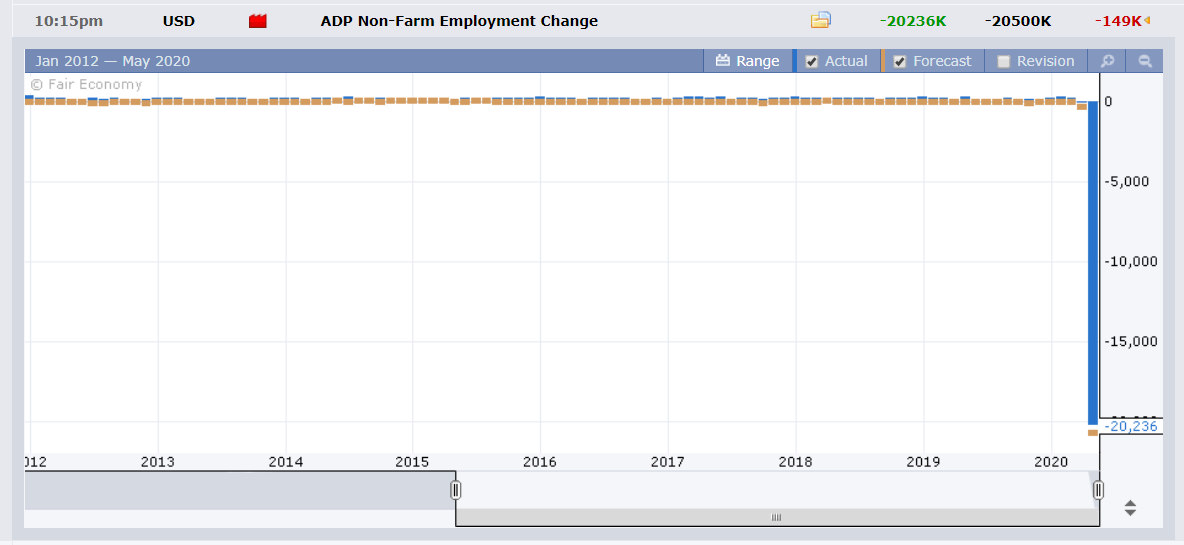Summary: The Dollar took a defensive role, climbing against its rivals bar the Japanese Yen, amid worsening economic data and trade war fears. US private payrolls in April showed a record of 20.236 million jobs lost based on the ADP Employment report. Across the Atlantic, Germany’s Factory Orders plunged -15.6%, the biggest fall since 2005. The coronavirus pandemic saw a slew of bleak economic forecasts by the Eurozone. US President Trump ramped up the rhetoric against China, raising doubts over its performance on the previous trade deal. The Euro fell for the third day in a row, losing 0.4% to 1.0795 (1.0837), near two-week lows. Sterling slumped to 1.2340 (1.2436), fresh weekly lows after UK Construction PMI suffered it’s largest fall on record. Against the safe-haven Japanese Yen, the Dollar dipped 0.35% to 106.10 from 106.52. Japanese traders return to their desks today after the Golden Week holidays. Commodity and Emerging Market currencies were all lower against the Greenback. The Australian Dollar retreated to 0.6385 in early Sydney from 0.6432 yesterday. The USD/CAD pair rallied to 1.4145 from 1.4055 as oil prices declined. Against the South African Rand, the US Dollar advanced 1.27% to 18.7300 (18.5500). Wall Street stocks finished in the red, the DOW losing 1% to 23,665 (23,867). The S&P 500 was down 0.89% to 2,845 (2,865). Global bond yields climbed with the benchmark US 10-year rate up 4 basis points to 0.70%. The US increased the amount of debt it plans to issue in its quarterly refunding auctions to a record high of US$ 96 billion according to a Bloomberg report. Germany’s 10-year Bund yield was up 5 basis points to -0.51% after their constitutional courts criticised the ECB easing measures.
Other data released yesterday saw Australia’s Retail Sales climb 8.5%, beating forecasts of 8.2%. Spain’s Services PMI slumped to 7.1 from the previous 23.0, missing expectations at 10.0. Other Euro area (Italy, German, France, and the Eurozone) Services PMIs mostly matched forecasts. The UK’s Construction PMI fell to 8.2 from 39.3, underwhelming forecasts at 21.0.

On the Lookout: Expect more grim economic reports out today. The main event is the Bank of England’s monetary policy meeting and rate decision. The BOE report is going to be released ahead of the London market opening and could see some FX fireworks.
Australia’s AIG Services Index and Trade Balance kick off the day’s reports. Traders will focus on the breakdown of exports and imports in the trade report. China, back from its Golden Week celebrations, reports it Caixin Services PMI’s and Trade Balance (in CNY and USD). European data start with Switzerland’s Unemployment rate followed by German and French April Industrial Production. The Bank of England monetary policy report and rate decision follows. The BOE is expected to keep its interest rates unchanged. Economic projections from the BOE will be in the spotlight. Canada reports its IVEY PMI’s. The US Weekly Unemployment Claims, forecast at 3 million, round up today’s reports.
Trading Perspective: In the leadup to tomorrow’s US Payrolls report, where markets are expecting the worst (-21.4 million jobs lost, 16.0% Unemployment rate), the US Dollar will keep its defensive role. The correlation of a strong US Dollar and weak risk assets is set to continue. The safe-haven Japanese Yen will be the exception, although with Tokyo back today, we can expect Japanese importers to support the downside of the USD/JPY pair.
Market positioning will continue to influence FX moves. The Euro risks lower as long bets were still near 2-year highs in the last Commitment of Traders report. Commodity cousins, the Aussie and Kiwi risk a reversal of their 6-week rallies. The resumption in the slump of oil prices saw the Loonie as worst performing major against the Greenback. Let’s get ready to rumble…















